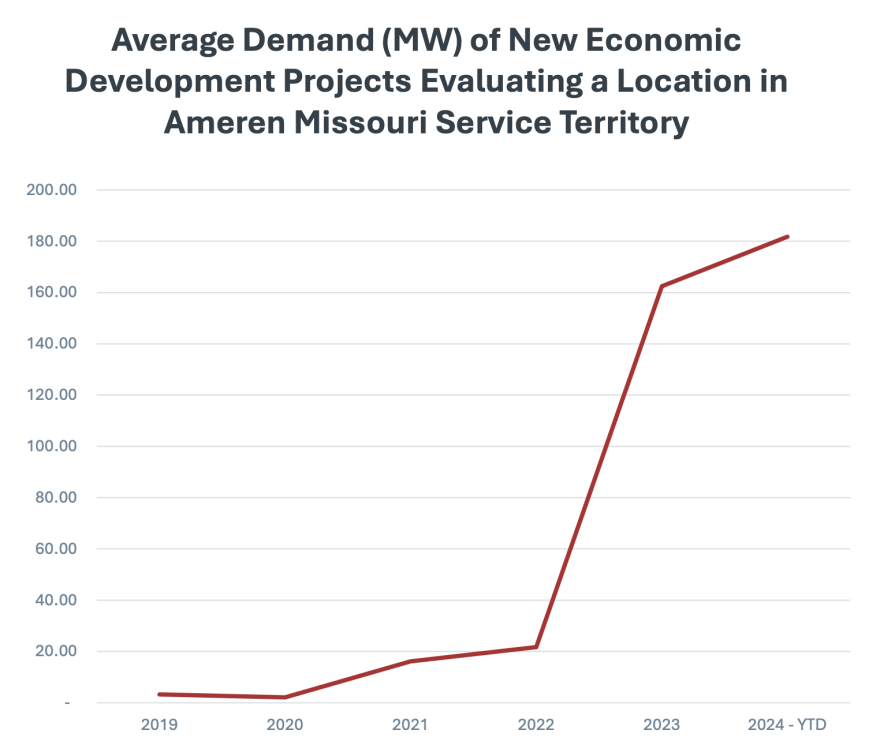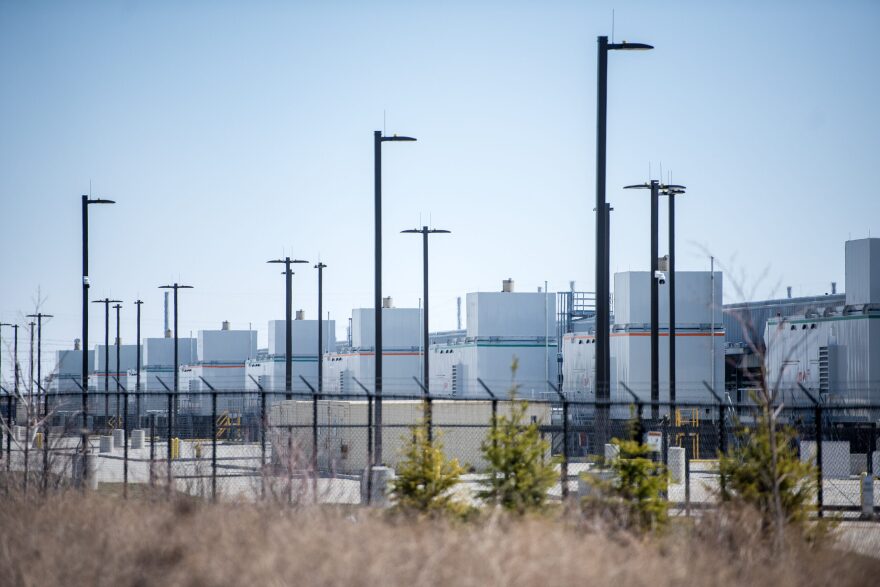In St. Charles this month, crowds of people opposing a proposed large data center showed up to public meetings to voice their concerns.
They decried the secretive nature of the project, whose owner still hasn't been revealed, and its potential impact on water quality.
The residents were also worried that their energy bills might go up because of the data center's potentially huge demand for electricity. The developer pulled the proposal for now but says it will be back.
In the meantime, Missouri's biggest utilities, including Ameren, are working to write new rules to govern how large data centers operate in the state. Advocates hope the new policies could also protect regular utility customers, like the ones who showed up in St. Charles.
What's happening
Two of Missouri's largest utilities, Ameren in the east and Evergy in the west, are both in the middle of Large Load Customer Tariff cases before Missouri's utility regulator, the Public Service Commission. Essentially, they are writing terms of service for when large data centers move into their areas and buy their electricity.
This process was spurred, in part, by the Missouri legislature passing a new utility law in March. SB4 requires large utilities to write tariffs, which are effectively terms of service, for customers requesting more than 100 megawatts of energy, to make sure that existing customers' rates don't reflect any "unjust or unreasonable" cost.
In filings before the PSC, Ameren representatives write that they are trying to balance two goals: attracting these new data center businesses and doing it in a way that minimizes risk.
"We need to have a framework where we can actually get some assurance about their commitment to the region before we make the investments in some of the infrastructure we need to serve them," said Steve Wills, senior director of regulatory affairs for Ameren Missouri.
To attract the businesses, the utilities are offering to build new power plants to meet their large energy demands, write clear policies for large customers and create subscription programs for renewable energy.
To minimize risk, the utilities are making rules to protect other customers from footing the bill if the data centers don't actually move in, or if they leave early. Ameren is proposing these requirements for data centers:
- Sign contracts for a minimum of 15 years of service.
- Commit to buying a minimum level of energy that is 70% of what they are contracted for.
- Post collateral or have a minimum credit rating to come in.
- Give two years' notice before terminating their agreements and would have to pay exit fees that would cover their minimum demand obligations for at least five years or the rest of their contract.
Ameren also wants data centers to sign Electric Service Agreements that would be approved by the Public Service Commission, giving state regulators a say over the terms of these data center agreements.

Why this is important
Extreme energy use
Data centers represent a potentially unprecedented increase in energy use, according to Ameren.
"They're really unique in terms of their service characteristics," Wills said. "And by unique, I mean, it's really just the size of them. They're very, very large."
In 2024, the largest individual Ameren customer had a peak electricity demand of 32MW. The company is writing these policies for customers requesting 100MW or more.
These rules will likely apply mostly to large data centers, but there is a possibility that other large industrial customers might need this level of service.
In its filings, Ameren said it already has large energy customers knocking at its doors, and some have taken steps to commit their business. The company has five projects that would fall under this Large Load Rate Plan, totaling 2,270MW of demand, and that have taken steps to commit to build.
That level of new energy demand will necessitate new energy sources, like power plants. So Ameren would need to build.
In most cases, costs for new power plants and other infrastructure are spread out among all customers through rate increases. But in this case, the investments are so large, the utilities need to make sure the data centers foot the bill for infrastructure that is only going in because of their demand.
"We're going to do everything that we possibly can to reasonably ensure that these customers are paying their fair share, and that we're not unjustly passing costs on to other customers," said Rob Dixon, Ameren's senior director for economic, community and business development.
If the rules are set up well, there is a possibility that these huge new customers could lower costs for everyone, said Geoff Marke, chief economist with Missouri Office of Public Counsel, the ratepayer advocate before the Public Service Commission.
"Over time, in theory, it should lower the overall bills for customers if it's done correctly," Marke said. "It's really an economy of scale argument more than anything, and an argument for utilities period is bigger is better in terms of being able to spread out cost and investments."

Speculative nature
The speculative nature of data centers represents a uniquely risky situation for utilities and their customers, said Jeremy Fisher, the Sierra Club's principal adviser for climate and energy.
As companies shop around for data center locations, they're asking utilities for information in multiple places. Fisher said the Sierra Club is tracking 23 utilities that have announced 700 gigawatts of demand in their economic development pipelines, which would represent more power than the U.S. currently uses.
"It is ridiculous to imagine that the data center sector is going to consume more electricity than all Americans consume today," Fisher added.
Even if they do move in, data centers could ultimately need less energy than they are signaling now. Fisher said there are two factors that could lead to less demand — artificial intelligence could become significantly more efficient, and the companies could end up not succeeding in their market.
Marke said there have been examples in Missouri of large businesses going under and leading to increased energy costs for all customers, like in the case of an aluminum smelter in New Madrid. He worries that could happen with AI, too.
"The AI, the data centers themselves, are part of a competitive marketplace," said Marke. "So there's no guarantee that each data center, each vendor, AI application, is ultimately going to be successful."
If data centers don't end up needing all the energy utilities think they do, it could leave those energy providers without a use or a way to pay for new, expensive power plants. That's where these large load tariffs could provide protections.
"One of the really positive things about having a large load tariff is that it ensures that the utility isn't building generation and transmission infrastructure on spec, but actually relying on a real market signal before it invests," Fisher said.
Climate implications
These cases will also potentially have big implications for the greenhouse gas emissions that are driving climate change because energy generation is the second-largest source of those emissions in the U.S.
The huge increase in energy use could be "effectively a rollback of our climate progress as utilities increasingly invest in gas and existing coal to meet those requirements," Fisher said.
In testimony before the Public Service Commission, Ameren officials repeatedly emphasize that data center customers want renewable energy to power their operations. Dixon wrote that 35% of Ameren's largest customers have sustainability goals, and large data center operators like Amazon and Google also prioritize renewable energy.
That spurred Ameren to propose four new subscription programs for large load customers to pay extra to receive wind, solar or nuclear energy.
But at the same time, Ameren has announced it will build two new natural gas plants in the coming years and more after that. Natural gas is cleaner than coal but still relies on fossil fuels and contributes to climate change.
Wills said natural gas is needed to fill in the gaps when renewable sources like solar and wind aren't on.
"You really need to capitalize on the strengths of every different technology that's out there," Wills said. "And so the natural gas generation is what we call dispatchable, which means it's available on demand."
In testimony, Ajay Arora, Ameren's senior vice president and chief development officer, said the company's plan is to get 70% of its energy from sources that can be turned on immediately, like natural gas or nuclear. The remaining 30% would come from renewables like wind and solar.

What's next
As both large load rate cases make their way through the regulatory process, outside parties are weighing in on the initial proposals from the utilities and sharing opinions on what they should look like.
Companies that are building huge data centers, like Amazon and Google, have officially joined the cases in Missouri meaning they will weigh in during proceedings. The Sierra Club and Renew Missouri have also done the same. And the case will include input from the Office of Public Counsel, which represents customers in Missouri.
These outside parties will push back, asking for changes in the policies. For example, in Evergy's case, Marke with the Office of Public Counsel has testified that these data centers should be subject to studies that look at energy efficiency, water use and how data centers might disturb the flow of electricity in the area before and after they are built.
"Right now, I would argue that a lot of this isn't very transparent," Marke said. "So getting that information out there, making that a priority on the front end, allows us to go ahead and benchmark it, allows us to better plan our finite resources moving forward."
Much like with a case in a court, briefs will be filed, evidentiary hearings will be held, and eventually the Public Service Commission will approve plans.
Evergy's case could be on the PSC's agenda at the end of this year, and Ameren's will likely come up in the beginning of next year.
Copyright 2025 St. Louis Public Radio



